When I got the call asking if I’d be willing to fly down to Kennedy Space Center and cover an event, I agreed immediately. Then about a week later, I remembered to call back and ask what I was supposed to be doing. Not that it mattered, I’d gladly write a few thousand words about the National Crocheting Championships if they started holding them at KSC. I hadn’t been there in years, since before the Space Shuttle program had ended, and I was eager to see the exhibit created for the fourth member of the Shuttle fleet, Atlantis.
So you can imagine my reaction when I learned that the event Hackaday wanted me to cover, the Cornell Cup Finals, would culminate in a private viewing of the Atlantis exhibit after normal park hours. After which, the winners of the competition would be announced during a dinner held under the orbiter itself. It promised to be a memorable evening for the students, a well deserved reward for the incredible work they put in during the competition.
 Thinking back on it now, the organizers of the Cornell Cup and the staff at Kennedy Space Center should truly be commended. It was an incredible night, and everyone I spoke to felt humbled by the unique experience. There was a real, palpable, energy about it that you simply can’t manufacture. Of course, nobody sitting under Atlantis that night was more excited than the students. Though I may have come in as a close second.
Thinking back on it now, the organizers of the Cornell Cup and the staff at Kennedy Space Center should truly be commended. It was an incredible night, and everyone I spoke to felt humbled by the unique experience. There was a real, palpable, energy about it that you simply can’t manufacture. Of course, nobody sitting under Atlantis that night was more excited than the students. Though I may have come in as a close second.
I’ll admit it was somewhat bittersweet to see such an incredible piece of engineering turned into a museum piece; it looked as if Atlantis could blast off for another mission at any moment. But there’s no denying that the exhibit does a fantastic job of celebrating the history and accomplishments of the Space Shuttle program. NASA officially considers the surviving Shuttle orbiters to be on a “Mission of Inspiration”, so rather than being mothballed in a hangar somewhere in the desert, they are out on display where the public can get up close and personal with one of humanities greatest achievements. Judging by the response I saw, the mission is going quite well indeed.
If you have the means to do so, you should absolutely make the trip to Cape Canaveral to see Atlantis and all the other fascinating pieces of space history housed at KSC. There’s absolutely no substitute for seeing the real thing, but if you can’t quite make the trip to Florida, hopefully this account courtesy of your humble scribe will serve to give you a taste of what the exhibit has to offer.
An Emotional Introduction
Before you get to see Atlantis herself, you’re directed into a long hallway that spirals in towards the center of the building. There’s gorgeous images from the history of the Shuttle program and inspirational quotes about what it was like to build and fly these incredible spacecraft on the walls to keep you placated, but it’s still a line by any other name. The designers clearly understood that the Atlantis exhibit would be a huge draw at KSC, so they made every effort to ensure the long line of visitors would be as comfortable as possible.
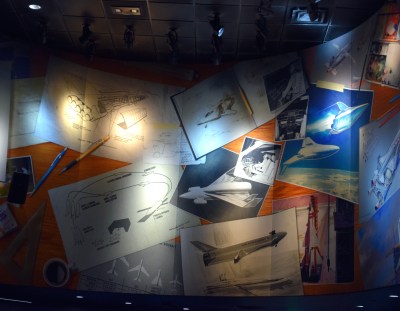 Of course, with the park closed we didn’t have to worry about the crowds. We were able to move swiftly through this area and directly into the theater. On either side of the screen, the walls were decorated with classic pulp art concept images of vehicles which only bare a passing resemblance to the final Space Shuttle, a hint about the sort of presentation we were about to see. A KSC staffer then spoke up and said we’d be watching a twelve minute film about the origins of the Space Shuttle’s radical design, and the challenges of turning it into reality.
Of course, with the park closed we didn’t have to worry about the crowds. We were able to move swiftly through this area and directly into the theater. On either side of the screen, the walls were decorated with classic pulp art concept images of vehicles which only bare a passing resemblance to the final Space Shuttle, a hint about the sort of presentation we were about to see. A KSC staffer then spoke up and said we’d be watching a twelve minute film about the origins of the Space Shuttle’s radical design, and the challenges of turning it into reality.
The film itself was fairly well done, though it did have that somewhat hokey feel which seems a hallmark of historical reenactments. They even did a respectable job aging the actors who were playing the various engineers attached to the project as they went through the decades-long development process between Max Faget’s early concepts for a winged orbiter and the first Shuttle flight in 1981.
That said, it did strike me as somewhat of an odd presentation for Atlantis. The design and construction process shown in the film was obviously for Columbia, the first operational Shuttle which was tragically lost in 2003. I can understand the desire to show the origins of the Shuttle program, but the way it was presented, I got the impression most people would be led to believe they were about to see the “original” Space Shuttle.
After the film was completed we were led into yet another theater, this time much smaller and with a wrap-around projection screen. Here you’re treated to real-life footage of the Shuttle during launch and landing, with computer generated renderings standing in for when the Shuttle was in space.
In the final moments of the presentation, Atlantis is shown in space, advancing towards the viewer. To the sound of fanfare, the screen retracted into the ceiling and revealed the real Shuttle behind it, suspended at the same rakish angle it was in at the end of the video. It was an impressive effect, and more than a few genuine gasps could be heard among the audience.
In the Presence of a Giant
We’ve all seen pictures and video of them, but if you’ve never seen one in person, you might not realize how incredibly big the Space Shuttle actually is. When the screen went up and the audience realized this mammoth spaceplane had its nose just a few paces away from us the whole time, it was quite intimidating. Maybe even a little frightening, on some subconscious level. Suspended at an otherworldly angle, robotic arm outstretched over your head, you almost can’t believe its real. Indeed, I overheard several of the students asking each other if it was the real Atlantis, or some kind of mock-up created for the exhibit.
On this level, a walkway goes the entire length of the orbiter, which gives you the closest view possible. With the skin of the craft perhaps only 4 feet away from you, you can appreciate all of the tiny surface details which never really come through in pictures. Many of the observers were surprised to see that the skin of the craft isn’t smooth like an airplane, instead, it’s a literal patchwork of thick and lumpy thermal protection blankets. I know it’s a thought completely unbefitting such a marvelous machine, but up close, I couldn’t shake the feeling that it looked sort of like a plush child’s toy.
There’s also an elevated platform that allows you a slightly higher vantage point. This gives a good view into the empty cargo bay, and another opportunity to realize just how big the vehicle is. All of the people in attendance could have comfortably fit inside the cavernous space with room to spare.
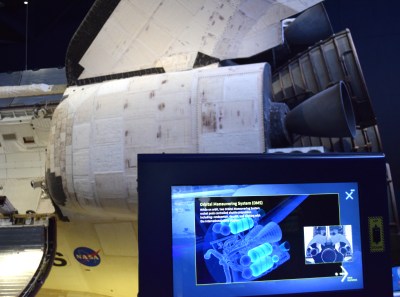 Dotted along this walkway are augmented reality terminals, which superimpose labels for the various components of the spacecraft over the live video feed from a camera mounted on the back. You could touch the different icons to get a brief description about that particular system and close-up 3D renderings.
Dotted along this walkway are augmented reality terminals, which superimpose labels for the various components of the spacecraft over the live video feed from a camera mounted on the back. You could touch the different icons to get a brief description about that particular system and close-up 3D renderings.
It was an interesting setup, but I have to admit that the augmented reality aspect seemed pointless. The terminals don’t move beyond a vertical adjustment for viewers of different heights, so it seems like they could have simply superimposed the information over a still image of that section of the Shuttle. Hopefully in the future they’ll be able to improve the system and allow you to actually pan the terminals left and right to get information on different sections of the craft.
Humble Beginnings
Once you get your fill of looking at Atlantis herself, you descend to the ground floor of the building where the majority of artifacts and displays are actually located. Here you can see various relics such as two of the Michelin tires that flew on the final mission of the Shuttle program, and the “beanie cap” vent hood that was used to vent gaseous oxygen away from the External Tank prior to liftoff.
They were all fascinating in their own way, but for me one of the most impressive objects on display here was a small balsa glider. Max Faget built this small model in April of 1969 to demonstrate his idea for a spacecraft that would launch vertically like a rocket and land horizontally like an airplane.
On the whole it’s almost unrecognizable as the origin point for the Shuttle suspended in the air above it. There’s only the slightest hints of family resemblance: a slightly upswept nose, boxy fuselage, and the large “body flap” control surface at the tail. Still, this little model was the first step towards a fundamental shift in spacecraft design.
Honoring the Fallen
Situated in such a way that you can’t leave the building without seeing it, there is a quiet area of the Atlantis exhibit that’s dedicated to the fourteen astronauts who lost their lives during the Shuttle program. Personal effects for each astronaut, donated by their families, are displayed in lighted boxes that line a short hallway leading into a silent and dimly lit room. Here visitors are presented with a rare and sobering sight: a large section of Challenger’s fuselage, along with the cockpit window frames from Columbia.
By having visitors walk through the snapshots of the fourteen astronaut’s lives before seeing the wreckage, the memorial makes it clear that while the material cost of losing Challenger and Columbia was enormous to the Shuttle program and NASA as a whole: it’s the human element that should never be forgotten.
Mission of Inspiration
As I said at the start, this brief account of my experience is no substitute for actually seeing the Atlantis exhibit in person. These are the elements that stood out to me the most, but represents only a small fraction of everything there was to see and do. From the very impressive Shuttle launch simulator to the full-scale model of the Hubble Space Telescope, there’s so much packed into this one building that no two visitors will have the same experience.
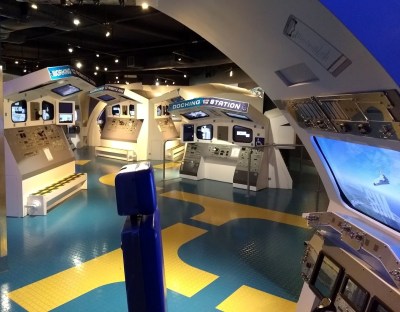
But no matter what course you plot through the permanent home of Space Shuttle Atlantis, one thing is abundantly clear: NASA did an incredible job honoring the program and making it accessible to visitors of all ages with this exhibit. While the general consensus is that retiring the Shuttle fleet without a clear successor was a mistake the American space program is still feeling the effects of, seeing how a room full of college students crawled over every inch of the exhibit made me realize it’s really something of a double-edged sword.
The public never had this level of access to the Shuttle during its operational years, and now that they’re retired, they’ll serve to inspire future generations of scientists and engineers in a way that wasn’t possible before. Atlantis may never fly again, but clearly her mission is far from over.


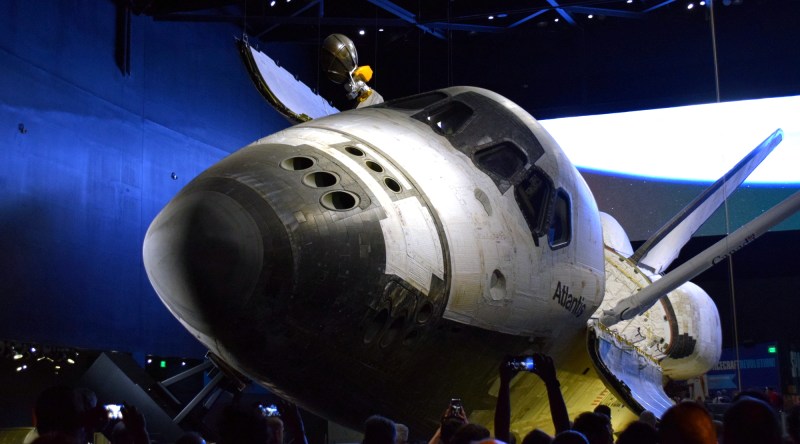
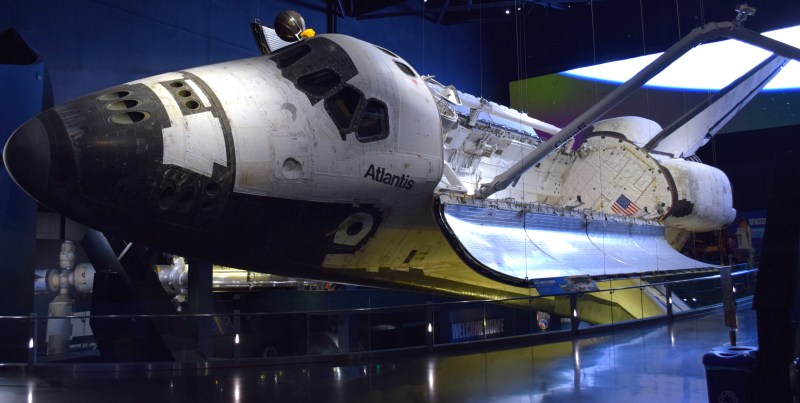

















Thanks for sharing! Missed the penultimate shuttle launch from KSC due to a technical issue, never got back to KSC after this.
Against all odds my 1-year old daughter loved the visit to KSC. In particular she was fascinated by the cockpit mockup with hundreds of switches to play with.
For us mere mortals, $60 is an outrageous price for admission to the KSC visitor center to see space craft that were paid for with our tax dollars.
Well, it’s only half the cost of the Disney parks…
Dream on…
https://www.wdwinfo.com/news-stories/walt-disney-world-annual-pass-prices-increase-substantially-overnight/
I don’t disagree. Nuclear family with two pre-teen kids, you’re easily looking at $200 total. Which doesn’t even include the extras like the bus tour, or food for that matter. Like many attractions, the pricing model is clearly setup to push you into the annual passes, but to me KSC is a “destination” sort of trip. In other words, you’re probably coming out of state (or country) for a potentially once in a lifetime trip. Only locals will be able to go multiple times in the same year, and even then, it’s not like there is a whole lot of variability in the collection.
That being said, I didn’t know until speaking with the staff during my trip that KSC is entirely funded by ticket sales and receives no money from the government. Not that I necessarily agree with that either (why not make it part of National Park Service?), but it did sort of put the cost of the tickets into a new light for me personally.
I will be the dissenting opinion here. The shuttle is / was a distraction from true human space flight missions. It was nothing more than a glorified truck. Intended to not venture beyond Earth orbit, it drained NASA’s budget and certainly did not “inspire” new generations of future explorers to try and venture beyond this “ruddy rock” (as Harry Mudd would put it).
The aerotech spin offs from the materials science used on it is notable, but beyond that, there was nothing particularly extraordinary about the shuttle platform.
It’s only extraordinary to people who understand technology. Good luck on your women’s studies.
I can understand where Kang’s coming from. The Space Shuttle program wasn’t bad for a manned orbital experimentation platform, but it was sold as being able to deliver launches much more often and on a much lower budget than what actually happened in the real world. Some of the problems were with the implementation – for example, apparently each shuttle had its own different set of tiles that had to be fitted specifically to that shuttle, which made refitting a lot more expensive. But many of the current designs for a new spacecraft have been more in the Apollo model, with a capsule at the top of a tube-shaped rocket.
In some ways, the Space Shuttle may have been a dead end – although I’m not sure if this was a case of something that was a bad idea at the outset, or a case where the only way to find its limitations in the real world was to build and fly a fleet of them.
From what I’ve read, the shuttle was intended to be part of a system of space vehicles and stations. It was the heavy lifting part of a much larger and well-designed system. You can thank the US government for killing the funding for the rest of the system and hobbling NASA. The shuttle wasn’t fundamentally flawed, but rather the system it was designed to be a part of never came into being thanks to the cowards in Congress.
As for whether or not it inspired a new generation: I was a child during the shuttle era, and remember the very first launch despite being only 7 at the time. The shuttle was the pinnacle of “high tech” then (that was the perception, anyway), and all of the science publications of the time published every detail about it, which I read hungrily. I also remember the Challenger disaster as if it happened yesterday, especially since Christa McAuliffe was a local hero to us New Hampshire kids. I may not have had the opportunity to become an astronaut or work in the space industry because my health sucks, but I sure as heck was inspired greatly by the space shuttle and its missions. I wasn’t the only one, either.
In 2003, shortly before the loss of Columbia, a documentary titled “Space Shuttle Garage” was shown on The History Channel, or possibly Discovery Channel. I only got to see part of it because it was shown just the one time. After Columbia that show got stuffed down the memory hole, never to be seen again, unlike most of the other shows on those channels that get shown over and over.
It was about all the work the Shuttles required between flights. One of the two parts I saw was showing a crew not being able to get the wheel nuts torqued correctly. They couldn’t get the special wrench to work right, so they got the other one (only two Space Shuttle Wheel Nut Torque Wrenches were made) and couldn’t get it to work right. Did they keep at it until they figured it out? Nope! End of shift they put a note in the massive procedure manual binder.
The other segment I saw was how they made new tiles. There’s a massive room with rows and rows of shelves, one section for each Shuttle. On those shelves are full scale 3D templates for every tile, no two identical, nor even exact mirror images for tiles in the same place on opposite sides of the same Shuttle.
Every tile has a number stenciled on in several spots, in case of damage or burn off. If all the numbers are defaced, they figure out the number from the tiles next to the damaged one. To locate the template, the tile’s card is pulled from a card file exactly like the ones libraries had gotten rid of a decade or more prior to 2003. With the card, the template is located and a block of silica foam is rough cut to size with a bandsaw. The template and foam block are mounted in a 3D pantograph milling/grinding machine. A cylindrical stylus with rounded end guides a same size diamond coated grinding cylinder inside an enclosure with a vacuum to suck up the dust.
After carving to shape, the tile foam is inspected, then hand dipped in the white coating, dried then fired. If it’s a black tile it gets a second coat over the white. Then the number stencil is pulled from another card catalog to use for air brushing the numbers,
At the time I thought by then they would’ve digitized all the tile shapes and used a CNC machine to carve replacements.
Same thing with the procedure manuals in the thick binders, and sticking notes in for problems. Putting all that information into a database with terminals on carts would’ve sped things up a lot. Crews could’ve logged their progress and entered problem alerts that would automatically pop up for the next shift’s attention.
I recall news reports several times of delays because noises were heard when a Shuttle was raised to vertical from horizontal. Probably something left loose because someone didn’t see a note stuck in a manual, or a note fell out and got lost.
At least there was no major oops like the NOAA-N Prime fiasco where one crew from another job ‘borrowed’ the bolts holding it to its turnover fixture without leaving a note, and the NOAA-N Prime crew also caught heat for failing to inspect the fixture mounting before tipping it.
Kang is correct that in some ways the space shuttle never lived up to the high hopes for the system, and it cost too much. However, it is not necessary for something to be a success for it to be an inspiration or historically significant. Percival Lowell was wrong about almost everything he ever said about mars, but his observatory still operates today and has made substantial contributions to astronomy. Freud was wrong about almost everything, but he started a ball rolling that matters today. Columbus wasn’t the first person to reach America and he did horrible things once he got here, but his voyage still mattered. In the end, it’s effect more than intention that will be remembered.
If you can’t make it to KSC to see Atlantis, try to stop by Udvar-Hazy just outside Washington DC, a very short cab/rideshare from Dulles airport to see Discovery. Also very moving. And humbling.
…and free other than the charge for parking.
Also, there is Shuttle Enterprise in the LA County Science Center. In time the plan is for it to be assembled with an external tank (also on display) and side boosters into a complete launch stack. Our visit in February of 2018 was spell binding. Enterprise sits on special earthquake proof mounts and is accompanied by a separate Rocketdyne built main engine. On the day that we visited one of the docents was a former Rocketdyne engineer who gladly escorted us around the exhibit answering our every question. It was truly a day to be remembered.
Should have said Space Shuttle Endeavour
I read the book by Mike Mullane (“Riding Rockets”) and can recommend it to anyone looking for a first-person account of the early years of the Shuttle era.
One thing I have a hard time relating to is the interior capacity of the crew cabin overall (not just the cockpit). How does it compare to e.g. common road vehicles (van, bus, etc.)?
Shuttle crew space volume listed here. https://spaceflight.nasa.gov/shuttle/reference/shutref/structure/crew.html
Was at KSC last December with the family. We spent nearly half a day just at the Columbia exhibit after watching the F9 launch that morning. Soooooo much to see in there, definitely worth the trip!
I used to work for the design firm that put together that exhibit, and I know a lot of people who would be thrilled to hear you enjoyed it! A few lucky bastards among my coworkers actually got to walk/climb through Atlantis to take reference photos for exhibit development; regrettably I was not one of them.
I ought to point out that the exhibit is meant to cover the shuttle program in its entirety as well as Atlantis specifically, which is why the pre-show covers the conceptualization of the shuttle and includes footage of Columbia and of other orbiters. The fact that Atlantis is the star physical artifact on display isn’t intended to take away from the rest of the program.
The part of the exhibit that I found I enjoyed the most was the unmounted RS-25 rocket engine. That is a fantastically complex chunk of plumbing, and even today it is one of the highest performing rocket engines in the world.
One interesting tidbit I learned when the firm visited the exhibit with an astronaut who had captained Atlantis, was that some of the shuttles had unique quirks in their performance. Atlantis was known for an unusual mode of buffeting or turbulence during re-entry, that astronauts referred to as the “Rocky Road.” I can’t imagine what it might have been like to fly about Atlantis for the first time and experience that…
I remember watching the first launch of Columbia on TV. There was a song someone had written specifically for the event, and it was played on TV before the launch. I don’t remember the name of it, nobody I’ve asked about it over the years remembers it.
Amazing article! I had the chance to see Space Shuttle Discovery last week and I cried tears of joy and awe. It’s really a breathtaking sight to see. Got a few great pictures of her. I plan on seeing all of the orbiters soon! Atlantis will be my next stop. Glad to know they have a little memorial there for Challenger and Columbus.
Hurricane Sandy broke Enterprise a little bit. (interestingly they found the tip that broke off, cleaned it up and riveted it back on) https://photos.google.com/photo/AF1QipOK4JH7TWg0bBiVV2a11J-UXF2-tgqBB8X2a-e_
The first time we (me, wife, and adult son) visited KSC in 2015, I had to be ushered out of the second theater to allow in the next group because I was stunned and crying from the time the screen lifted and exposed Atlantis to us. She became my giant spaceship girlfriend. When we went back in 2017, I had the presence of mind to record the videos for posterity:
https://youtu.be/EdS_fopOoek
That “so called” truck hauled and repaired the Hubble telescope into space. The Hubble is referred to as one of the most important astronautical tools in the last 500 years. It also hauled up Chandra, another valuable telescope. Most of the ISS depended on the Shuttle to build it – this taught humanity to work, build and repair structures in space. Moving forward, oh how I love the CAPSULES that resemble those of the 1960’s. Then you add the brilliance of our government who cancels programs on a whim. Until we get far thinking intelligent people in our government, there will be no Enterprise-class spaceships.
For those that find this interesting I strongly recommend “Bringing Columbia Home: The Untold Story of a Lost Space Shuttle and Her Crew” as told by by Michael D. Leinbach (Author), Jonathan H. Ward (Author), Robert Crippen (Foreword). It is a deeply heartfelt telling of the days after the tragic loss of the Space Shuttle Columbia and how nearly 25,000 persons contributed to the recovery effort.